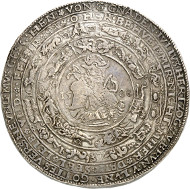In collaboration with London Coin Galleries, the auction house Künker will offer as many as 12 Julius löser, of several dates and weights, on October 30, 2015. These impressive coins tell of one of the most remarkable rulers of the 16th century and a numismatic success story.
Brunswick and Lüneburg. Julius, 1568-1589. Löser of 10 reichstaler 1574, Heinrichstadt (Wolfenbüttel), minted at a weight of 9 reichstaler. Nominal value engraved. Estimate: 10,000 GBP.
The oldest lösers date back to the year 1574. They are fascinating specimens. On the obverse, they depict Duke Julius of Brunswick-Lüneburg in armour, the battle axe in his right hand, his left placed on the hilt of his sword. Engraved to his left and right is the year the coin was struck. The duke’s coat of arms, held by two wild men, decorates the reverse. The man on the right presents a torch, the one on the left an orb, which offers free space for the punch featuring the value. The visual separation of letter and motif bands by lines is characteristic of the coins. They do not only carry the title of their minting authority, ‘By grace of God, Duke Julius of Brunswick-Lüneburg’, but also a specific description of the coin, ‘New coin, minted in Heinrichstadt according to the imperial regulations for weight and fine content, called Brunswick Julius löser in the weight of 10 thalers’ (both in translation). Added to this are further quotes, mainly from the Holy Scripture, as well as a highly unusual depiction of the twelve zodiac signs and the seven personified planets of the sun system.
Duke Julius of Brunswick-Lüneburg (1568-1589).
Responsible for the coinage is Julius of Brunswick-Lüneburg (1568-1589). He was an exceptional figure in the 16th century. Suffering from a walking disability and once destined to become a priest, he took over his father’s territory due to the death of his older brother. The country he inherited was in a dire state. But thanks to his exceptional education he was able to implement an effective economic policy. The ruler became an entrepreneur. One of his projects was the Julius löser, an international currency suited for long-distance trading as well as saving.
Today, we often fail to fully recognise what it means that in the Early Modern Period only some coins were suited to be saved and put away for many years. Most denominations used for the daily business resemble our fiat money: the silver content did not even come close to the nominal value. Such coins lost their value outside country borders and regularly even in their own circulation system as soon as the ruler officially invalidated and exchanged them – of course for a surcharge – for a new currency. At a time where tax collection was still in its infancy, this procedure was one of the few methods to generate reliable revenue.
So saving money only made sense if the coins’ intrinsic value did not differ from its nominal value, which was the case with thalers, ducats and of course multiple thalers such as the lösers issued by Julius.
Numismatists interpreted these Julius lösers in even more, interesting ways. A very unreliable source was sought out, which said that every citizen of Brunswick-Lüneburg was obliged to buy a certain number of coins, so that they would be able to loan them to their ruler in the case of an emergency. Just considering the effort necessary to implement such a measure one rather quickly reaches the conclusion that the source, which, to complicate things further, was written two generations later, must have misunderstood something. Today, this interpretation is completely obsolete.
Hamburg. Portugalöser weighing 10 ducats, no date (1578-1582). Künker 256 (2014), 7090.
As a matter of fact, there is an inconspicuous source which is far more helpful when it comes to revealing the intention behind Julius’ lösers. On 7 October 1573, still a couple of months before the minting of the first Julius lösers, the duke issued an official tariffing. In the Early Modern Period, such a tariffing corresponded roughly to the brightly coloured digits that we see on the display panels of exchange offices around the world today. A tariffing fixed the rates at which coins could be exchanged and stated the fees that were due for such an exchange. What is interesting is the place that Julius’ lösers hold in the ranking. It is listed immediately after the portugalöser, which indicates that Julius wanted his new coin to be associated with the already introduced and highly popular denomination.
Prince Henry the Navigator during the conquest of Ceuta 1415, panel of azulejos by Jorge Colaco at the Sao Bento railway station. Photograph: HombreDHojalata / http://creativecommons.org/licenses/by-sa/4.0/
The Hamburg portugalöser were gold coins at a weight of 10 ducats and modelled on the Portuguese 10-cruzado pieces. The latter were known all across Europe since the main importer of North African gold, Portugal, exported the gold to Northern Europe in precisely this form. Hence the name. A portugalöser was nothing but a Portuguese gold coin. Whether they came straight from Portugal or from Hamburg, the portugalösers were high-quality coins, highly estimated in the international trading world thanks to their stable weight and gold content, which made them particularly valuable for saving. In return, people were willing to pay a high surcharge for the exchange, and Julius of Brunswick-Lüneburg counted on that.
Thanks to his mining activities in the Harz region, the duke on his part was also in possession of a coveted resource: silver. He intended to use this silver in order to establish a stable currency suitable for long-distance trading and savings investments, which would also bring in a considerable amount of money through the surcharge. The already mentioned first tariffing fixed the price of one Julius löser at 15 Mariengroschen. That was a lot. After all, a “regular” thaler only cost one Mariengroschen. Which means that the Julius löser, by comparison, cost one and a half times as much. And the duke was still trying to generate additional revenue. While all lösers from 1574, the first year of minting, display the nominal value of five and ten thalers respectively, their actual weight was only nine and four and a half thalers respectively.
Brunswick and Lüneburg. Julius, 1568-1589. Löser of 8 reichstaler 1588. Heinrichstadt (Wolfenbüttel). Nominal value punched. Estimate: 15,000 GBP.
There are two thinkable explanations for this phenomenon. Either the dies could have already been cut when the decision was made to mint the thalers at a lesser value. Or the divergence of the intrinsic value from the nominal value was meant to encourage people to spend the large silver coins in Brunswick-Lüneburg, where they were worth round about 10 % more, rather than elsewhere. The latter could be understood as a measure in monetary policy.
Be that as it may, the lösers, minted under weight by the government, could not be destined to succeed. As early as 1576, the pieces’ were manually punch-marked and their nominal value was adapted to its real value.
Even if the Julius lösers were never as widespread as the Hamburg portugalöser, they became a huge success with the collectors, not with the savers. We know that already in 1722, the price for a Julius löser was 40 to 50 thalers. For a löser of 10 thalers that meant, after all, four to five times the value of the silver content. The mint masters in Brunswick-Lüneburg took advantage of that. They still had the original coin dies of the mint and used them to mint the popular collector’s items on demand. Not all of them were full weight. It was cheaper this way by guaranteeing either a bigger profit for the mint master or a lower price for the buyer.
Anyhow, in 1699 Rudolf Bornemann, mint master in Zellerfeld and Goslar, was approached by the administration and instructed that if he continued to sell lösers in the future, he was to consult the Münzwardein and ensure the coins had the correct weight.
So lösers were prestigious collectibles as early as the 17th century, collectibles that not everyone could afford. But the wonderful coins with their detailed imagery also provide a unique insight into the world of an Early Modern ruler and the things he prided himself with most.
We at the auction house Künker are happy to present to you the löser collection of the Preussag AG, today TUI AG, in cooperation with London Coin Galleries Ltd. The collection is the largest löser-collection that has ever been on the market.
There are 12 Julius lösers alone – differing in year of issue and weight. The entire catalogue holds 217 lösers and 327 mining coins.
Please find the auction at which the mentioned löser are currently being offered here.
And please read the auction’s preview published in CoinsWeekly here.










